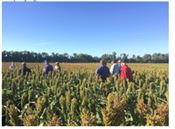|
Planning For Next Season
DR. BRENT BEAN
LUBBOCK, TEXAS
Way back in my junior high days – that's middle school for you millennials – a favorite teacher of mine used to say, “If ifs and buts were candy and nuts, we would all have a merry Christmas!” Certainly corny, but the saying has a ring of truth to it that always stuck with me. As growers begin to think about and prepare for next year’s crop, it is helpful to think back on the “what ifs” of last year. What if I had planted a different variety? What if I had added a little more nitrogen? What if I had increased my seeding rate 20 percent? Such questions are important to ask as growers make plans for next year.
One of the first steps in planning a sorghum crop is to set an optimistic, yet realistic yield goal. Management input decisions from planting date to seeding and nitrogen rates will depend on the goal. The goal should be based not only on a grower’s previous experience but also on extension trials, discussions with other top growers in the region and visits with knowledgeable seed company agronomists and other consultants.
Sorghum growers should begin thinking about their hybrid choices for next season and diligently review university and company data when selecting a hybrid. Many seed companies have extensive seed guides and agronomists on hand to help find the seed that best fits the agronomic profile of a specific field. More on the characteristics to consider in a hybrid will be discussed in next month’s column.

Now also is the time for growers to think about how their weed control program worked last year and how to best control weeds in next year’s crop. Growers must control weeds prior to planting and then implement a good preemergence program. Every grower has herbicide choices, and these choices should be narrowed down and carefully selected to best control problematic weeds on a particular farm. Most states have good research and extension programs that compare herbicide treatments for a range of weed species. In side-by-side comparisons, some products provide little difference in weed control effectiveness, so growers should take the time to compare prices to minimize cost while optimizing weed control.
During the late winter and spring months, growers should collect soil samples for nutrient analysis to determine the amount of fertilizer needed for the next crop. Keep in mind that if the previous crop was soybeans, growers should account for a credit of 20 to 40 pounds of nitrogen, depending on soil type and soybean yield harvested. Adding the correct amount of nutrients to the soil is critical to achieving sorghum yield goals. State extension nitrogen requirements vary greatly, but most research strongly suggests that 1.2 pounds of nitrogen is needed for every bushel of grain produced.
Today, growers have ready access to information to help them make crop management decisions. However, separating the good from the bad information is not always easy. The United Sorghum Checkoff Program strives to maintain a website with only the most credible and science-based information available. One of the most useful resources is the Agronomy Library page, where articles on over 30 topics are housed. Growers can search for “sorghum checkoff agronomy library,” and most search engines will find the page. ∆
DR. BRENT BEAN: USCP Agronomist

|
|